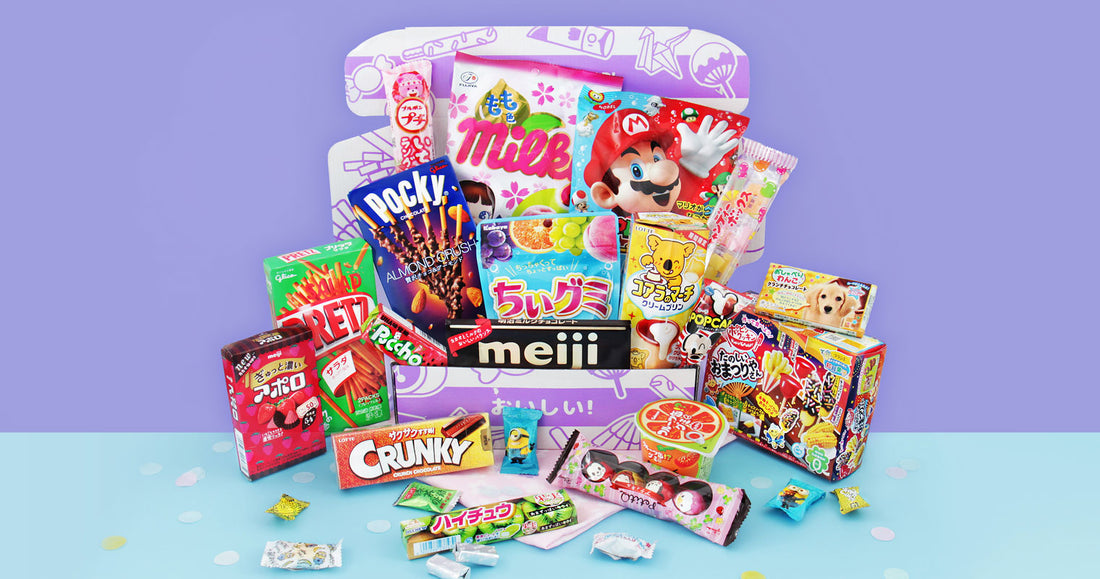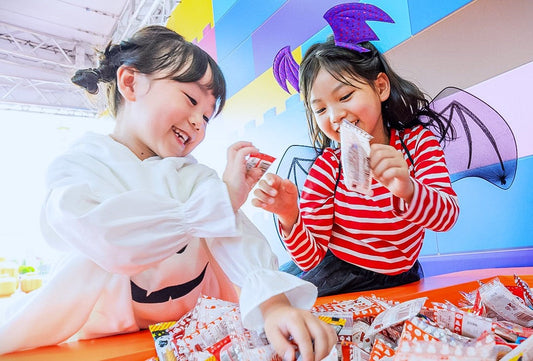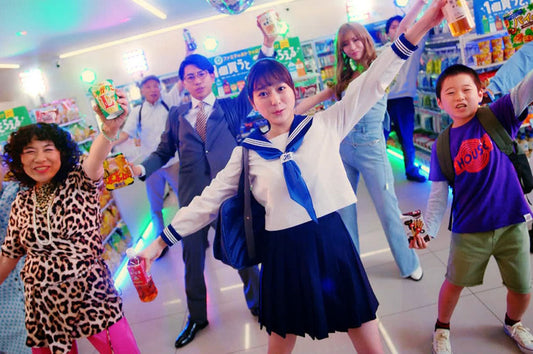If you're hoping to learn more about Japan, then heading to a matsuri or Japanese festival is a great way to immerse yourself in Japanese culture and traditions. Not only do these community gatherings showcase performances, parades, and festive cultural activities, but they also give you a chance to sample a ton of tasty festival food!
Let's jump right in!
-
Okonomiyaki (おこのみやき)
- Takoyaki (たこやき)
- Yakisoba (焼きそば)
- Ikayaki (いか焼き)
- Yaki Tomorokoshi(焼きとうもろこし)
- Yakitori (やきとり)
- Korokke (コロッケ)
- Torikawa Gyoza (とりかわ餃子)
- Nikumaki Onigiri (俵おにぎり)
- Karaage (から揚げ)
- Gyu-kushi (牛串)
- Grilled Ayu (やきあゆ)
- Baby Castella (ベビーカステラ)
- Yaki Mochi (やきもち)
- Age Mochi (揚げ餅)
- Dango (団子)
- Sweet Potato Chips (さつまいもチップス)
- Ringo Ame (りんご飴)
- Choco Banana (ちょこばなな)
- Wata Ame (わたあめ)
- Taiyaki (鯛焼き)
- Donguri Ame (どんぐり飴)
- Amezaiku Candy (飴細工)
- Ichigo Daifuku (いちご大福)
- Kakigori (かき氷)

From savory goodies like takoyaki to sweet treats like kakigori, you'll find matsuri no tabemono (Japanese festival foods) will keep you clamoring for more! Put on your cutest festival kimono and grab a fun little tote bag because we're heading out to learn more about Japanese festival snacks!
1. Okonomiyaki (おこのみやき)

Okonomiyaki is a matsuri staple that you should definitely add to your plate at a festival! Also known as savory pancakes in English, Okonomiyaki is usually made up of cabbage, meat, seafood, and occasionally noodles, all mixed in a batter that's cooked on top of a griddle. Once cooked, it's topped with okonomiyaki sauce (a special sweet and salty sauce), mayonnaise, and dried seaweed.
In Japan, there are two famous types of okonomiyaki that you can try out: Osaka-style okonomiyaki and Hiroshima-style okonomiyaki. The Osaka-style okonomiyaki is made by mixing the ingredients with a flour-based batter and then grilling it on top of charcoal. Meanwhile, the Hiroshima-style okonomiyaki has the cook stack all of the ingredients on a layer and then add on some yakisoba or grilled noodles. Oishi!
2. Takoyaki (たこやき)

This ball-shaped Japanese snack is another matsuri favorite! Made from flour-based batter and bits of octopus and vegetables, takoyaki is cooked on iron plates with half sphere-shaped dents. Served on the spot, they have a crispy crust and a gooey center with chewy octopus bits inside. You can always get them with okonomiyaki sauce, bonito flakes, and a drizzle of mayonnaise.

Depending on which festival you get them from, there are different takoyaki variations that you can try. Some stalls use other ingredients aside from octopus, like kani (crab sticks), shrimp, mentaiko (salted pollock roe), tempura, bacon bits, cheese, and even curry. Have fun roaming around different festivals and discovering all sorts of takoyaki!
3. Yakisoba (焼きそば)

Yakisoba (Japanese fried noodles) is another crowd favorite at Japanese festivals or matsuris. You'll find them at yatais or Japanese festival stalls being cooked on a large iron plate. Made with noodles, pork, cabbage, carrots, and onions, these noodles are seasoned with a sweet and savory brown sauce.
There are many different types of yakisoba in Japan! The most common is Sauce Yakisoba, which uses Worcestershire or oyster sauce. Then there's Shio Yakisoba, which has a lighter salt flavor. Ankake Yakisoba uses a thick sauce slathered over vegetables, meats, and seafood. Last but not least, you have Kata Yakisoba, which has crunchy grilled noodles covered in sauce!

You can also find specialty yakisoba in different cities in Japan. In Fujinomiya city, you have the Fujinomiya Yakisoba, which includes nikukasu or meat crumbs. Not only does it add flavor, but it also adds texture to the dish. Oota Yakisoba comes from Ota City and uses green seaweeds and red ginger as toppings. Its dark sauce is spicy and slightly sour. Yokote Yakisoba from the Akita Prefecture is relatively sweet with minced pork, thick noodles, and a sunny-side-up egg on top of it.
4. Ikayaki (いか焼き)

Another popular matsuri-favorite is ikayaki or whole grilled squid. Seasoned with soy sauce, this tasty treat can be served whole on a stick or cut into rings. It's warm, savory, and chewy! Lighter than okonomiyaki or yakisoba, ikayaki is a great snack to chew on while having drinks on the festival grounds.

In Osaka, ikayaki is a little bit different, though. Instead of having the squid grilled, it's served as a pancake or crepe. Folding the crepe together with chopped squid, Worcestershire sauce, and sometimes egg, the ikayaki pancake is pressed between two iron plates. This style of cooking the squid is fast and appetizing!
5. Yaki Tomorokoshi(焼きとうもろこし)

This festival snack might seem simple enough, but yaki tomorokoshi (grilled corn on the cob) is a super tasty treat to nibble on while checking out stalls at a matsuri. Seasoned with a soy sauce-based sauce, yaki tomorokoshi is sweet and salty with charred parts that add depth to its flavor.
6. Yakitori (やきとり)

Another common treat that you can find at yatai stalls in a Japanese matsuri is yakitori, or skewered chicken. Seasoned with a savory sauce, these chicken bits are grilled to perfection. The aroma alone makes your mouth water!

There are different types of yakitori depending on which part of the chicken is being skewered. Momo yakitori is when chicken thigh meat is skewered. Negima yakitori is a mix of chicken thighs and thick pieces of spring onion.
Reba refers to skewered chicken liver pieces. Tebasaki is the name of skewered crispy chicken wings. Strips of fatty chicken skin that are grilled until crisp are called torikawa. Last but not least, we have stukune, skewered chicken meatballs made from minced chicken, egg, spices, garlic, and spring onions.
7. Korokke (コロッケ)

A great example of Japanese yoshoku or Western-style food, korokke is actually based on French croquettes. Made of mashed potatoes mixed with sautéed ground beef and onions, these tasty treats are deep-fried to perfection! They're often served with a sweet and savory sauce.

There are many different types of korokke based on the ingredients, with the most common one being potatoes. Tuna korokke, as the name implies, is made with tuna. Yasai Korokke is made with mixed vegetables. Curry korokke has a spiced curry flavor. Kabocha korroke is made using pumpkins. Other korokkes are okara, cream (made with white sauce), and gurutan, which is made with white sauce and macaroni.
8. Torikawa Gyoza (とりかわ餃子)

If you're a fan of Japanese cuisine, you've probably heard of gyoza (steamed dumplings). But have you heard of torikawa gyoza? Instead of using gyoza wrappers, these dumplings use chicken skin to carefully wrap around tasty filling made of vegetables and ground meat. These dumplings are crispy and juicy at the same time!
9. Nikumaki Onigiri (俵おにぎり)

Traditionally, onigiri are rice balls with a tasty center made of tuna or meat. Nikumaki onigiri takes onigiri a little bit further by covering these rice balls in thin slices of pork or beef. Seasoned with a soy sauce-based sauce, nikumaki onigiri are grilled on top of an open fire. Topped with mayonnaise and cheese, they're super yummy and filling.

Though its origin is uncertain, rumor has it that nikumaki onigiri was created as a staff meal at an izakaya (Japanese pub) in the Miyazaki prefecture in Japan during the 1990s. Now it's become a popular dish that often finds its way into yatai stalls in Japanese festivals!
10. Karaage (から揚げ)

Karaage is Japanese-style fried chicken that's loved almost everywhere in Japan. Though you'll mostly find them at izakayas or Japanese pubs, karaage is also a staple at matsuris. It's usually made of marinated chicken coated in a batter consisting of flour and potato starch.

There are regional types of karaage in Japan that you can take your time to discover. In Hokkaido, there's zangi, which is made with a special marinade and served with a spicy dipping sauce. Chicken nanban is Miyazaki prefecture's version of karaage, which is dipped in sweet vinegar and topped with tartar sauce. Another example of regional karage is tebesaki, which is made with bone-in chicken wings that are sprinkled with sesame seeds and basted with a special sauce.
11. Gyu-kushi (牛串)

Fully known as beef kushiyaki (牛肉の串焼き), gyu kushi are Japanese-style beef skewers. Though they're usually made with high-quality Wagyu beef cubes that are seasoned simply with salt and pepper, there are other types of gyu kushi made with cheaper cuts of beef.
12. Grilled Ayu (やきあゆ)

Ayu is a species of sweetfish that can be found in Japan. Small and slim, ayu can only survive in extremely clean water, making it "the queen of clear rivers." Considered a summer delicacy in Japan, they can be cooked in many ways, though the classic method is to simply season them in salt and grill them over charcoal.
It might seem odd to eat whole fish while walking around at a matsuri, but nibbling on grilled ayu is something that you have to try! The fish has a slightly sweet taste that's somewhat like melon or cucumber. When grilled, the skin of the fish becomes crispy, and it's fun to nibble on the fish's tail and fins.
13. Baby Castella (ベビーカステラ)

We've come to the sweeter portion of the matsuri! Baby castella is the mini version of Japanese castella cakes, a type of sponge cake that’s compact and moist. Like their larger counterparts, baby castellas are spongy and moist, and they pair perfectly with milk tea or coffee. The only difference is that baby castellas are rounder, and they have a crispy outer layer. Some baby castella cakes have all sorts of fillings like azuki red bean paste or cream!
14. Yaki Mochi (やきもち)

Yaki mochi is mochi (rice cake) that's grilled on top of searing charcoal. Though these tasty treats are usually eaten during New Year's in Japan, you can also find a lot of yaki mochi at festivals. They're chewy, and the charred parts give a tasty kick to the mochi!

If you're lucky, you'll find different kinds of yaki mochi at a festival. There's isobeyaki ( 磯辺焼き), which is yakimochi grilled with soy sauce and wrapped in nori seaweed. Abekawa yakimochi is a different type of yakimochi altogether. Broiled and soaked in hot water, it's covered with a mixture of sugar and kinako (roasted bean powder).
15. Age Mochi (揚げ餅)

Another type of mochi treat, age mochi, is a deep-fried rice cake. They're usually seasoned with sweet soy sauce and dressed with seaweed for an extra hint of saltiness. This mochi combines sugar, umami, and saltiness all together. Sometimes you can find age mochi with cheese in the middle!
16. Dango (団子)

Made with a mix of regular rice flour and glutinous rice flour, dango are sweet rice balls that you'll find at almost any Japanese matsuri. Normally, you'll find three to five pieces of dango served on sticks. Most of the time, you'll get the dish drenched in sugar, sweet soy sauce syrup, or adzuki red bean paste. Also considered a wagashi (a traditional Japanese dessert), dango is often served with green tea.
17. Sweet Potato Chips (さつまいもチップス)

Sweet potatoes are a popular Japanese treat during the autumn season, so it shouldn't come as a surprise that autumn festivals would have sweet potato chip stalls. Made from thinly sliced Japanese sweet potatoes, these treats are fried to perfection and then coated in sugar or other seasonings. Though most people enjoy them plain, you can have other toppings like butter and chocolate.
18. Ringo Ame (りんご飴)

Otherwise known as candied apples, ringo ame are usually whole apples covered in syrup and skewered on a stick. Most of the time, you can find ringo ame at summer festivals or natsu matsuris! Aside from the layer of sugar, some yatai stalls serve ringo ame with other toppings like chopped peanuts, candy, or chocolate.

If apples aren't your thing, you can also find other candied fruit at the matsuri, like candied grapes, orange slices, and strawberries. They're easier to eat because they're more bite-sized! Not only that, but the tartness of other fruits like strawberries and oranges goes really well with the sugar coating.
19. Choco Banana (ちょこばなな)

Just like the name implies, choco bananas are chocolate-covered bananas served on top of a stick. These sweet banana treats are especially popular at festivals in Japan. A lot of these chocolate-covered treats have other toppings on them, like sprinkles and chopped nuts. You can get the bananas in different flavors like white chocolate or strawberry chocolate!
20. Wata Ame (わたあめ)

In English, Wata Ame is simply known as cotton candy. While some are sold in plastic bags, you can also get wata ame on sticks. In some places, wata ame can be fancy and colorful!
21. Taiyaki (鯛焼き)

If you directly translate taiyaki into English, then you'll get "grilled sea bream." However, taiyaki at Japanese festivals isn't grilled fish at all. Instead, they’re sea bream fish-shaped cake treats filled with anko or sweet bean paste. They’re soft, warm, and oh so tasty!

Sometimes you'll find taiyaki with other fillings like custard cream, matcha tea cream, and chocolate. If you visit matsuris during spring, you might even be able to find sakura taiyakis! They have a bright pink color and sometimes they're filled with sakura cream.
22. Donguri Ame (どんぐり飴)

Literally translating to acorn candy, donguri ame are big, hard, and colorful Japanese candies that you'll find at yatai stalls in festivals. Most of the time, though, you're more likely to find them in matsuris in Osaka than in Tokyo. You can discover all sorts of candy flavors, from mandarin oranges to peaches to Calpis!
Looking for unique Japanese candy like donguri ame? Then check out Japan Candy Box. We're the number 1 Japanese snack box with the biggest selection of candy from Japan.
23. Amezaiku Candy (飴細工)

More art than simple candy, amezaiku is crafted by an artist who takes multi-colored mizuame (sugar syrup) to create an elaborate sculpture. Amezaiku candy usually comes in the shapes of goldfish, animals, and insects to appeal to children. These beautiful candies used to be common among shrine festivals. Now, they're a bit hard to find!
24. Ichigo Daifuku (いちご大福)

Made of mochi stuffed with red bean paste and topped with a fresh strawberry, ichigo daifuku is both tasty and eye-catching. This special treat can commonly be found at festivals in and around Kyoto! It's also seasonal, meaning that you can only find daifuku during spring when strawberries are abundant.

Besides red bean paste, there are other types of daifuku fillings that you can indulge in. Custard cream ichigo daifuku is a crowd favorite. White bean paste also goes well with the mochi and the strawberry. Some people also use matcha mochi to pair with the red bean and strawberry. Sometimes you'll find it paired with heavy cream and anko!
25. Kakigori (かき氷)

Also known as a shaved ice dessert, kakigori is a favorite during natsu matsuri or summer festivals. Unlike the kakigori that you can find at specialty shops with elaborate toppings, matsuri kakigoris are simpler with fruit flavors and condensed milk. Some popular flavors include strawberry, orange, mango, melon, cola, lemon, and matcha!
Kakigori is also a popular summer snack in Japan, and you can find a ton of shops that specialize in unique kakigori with all sorts of toppings and mix-ins. If you'd like to read more about other summer treats in Japan, then you can check out our blog, The Top 10 Must-Try Summer Snacks in Japan.

Alright, we’ve come to the end of the festival, and we hope you’ve had your fill. Have you ever been to a matsuri before? Which matsuri snack have you tried? Which would you like to try if you ever get to visit Japan?

Are you interested in nibbling on elegant Japanese candy like amezaiku? Or would you rather chow down on some okonomiyaki? Don’t be shy and let us know in the comment section below. Good food is something to talk about!







